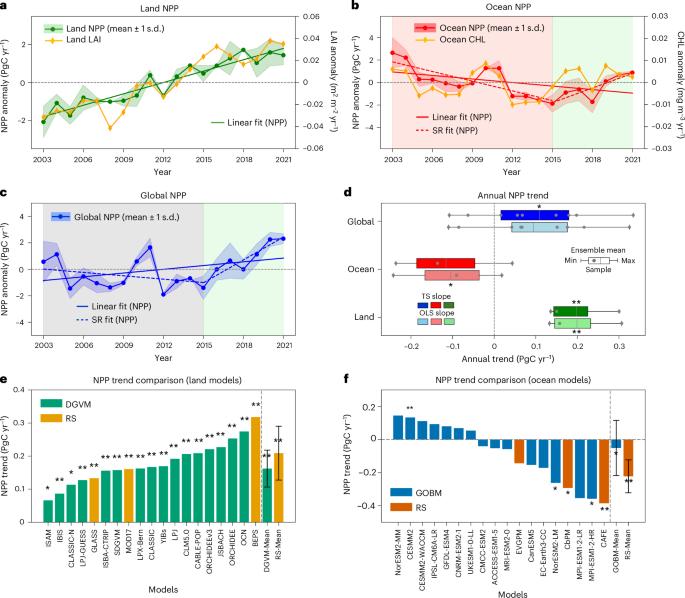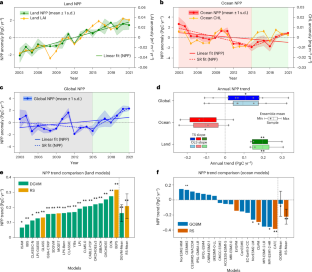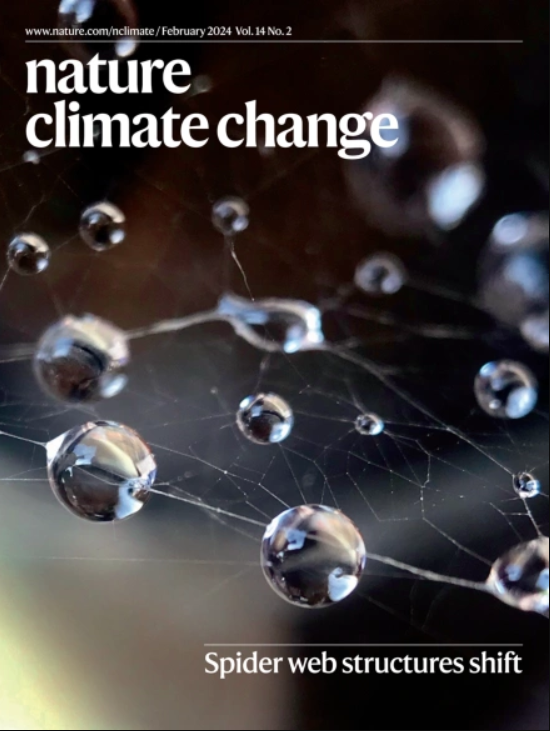Contrasting biological production trends over land and ocean
IF 27.1
1区 地球科学
Q1 ENVIRONMENTAL SCIENCES
引用次数: 0
Abstract
Terrestrial and marine ecosystems constitute the primary components of the Earth’s biosphere, yet their photosynthetic productions are typically studied separately, which limits understanding of planetary carbon uptake and biosphere health. Here, using multiple satellite-derived products, we identify contrasting net primary production (NPP) trends between land and ocean, probably reflecting their differential sensitivity to climate warming, especially in tropical regions. Planetary NPP shows an overall increase of 0.11 ± 0.13 PgC yr−1 (P = 0.05) from 2003 to 2021, driven by a significant terrestrial enhancement of 0.20 ± 0.07 PgC yr−1 (P < 0.001) and partially offset by an oceanic decline of −0.12 ± 0.12 PgC yr−1 (P = 0.07). While land contributes to the strong upwards NPP trend, the interannual variability in global NPP is predominantly driven by the ocean, especially during strong El Niño–Southern Oscillation events. Our findings highlight the resilience and potential vulnerability of biosphere primary productivity in a warming climate, calling for integrated land–ocean monitoring and assessment to support climate mitigation initiatives. The authors jointly assess the changes in land and ocean net primary production from 2003 to 2021. They show contrasting trends, with overall planetary increases (0.11 ± 0.13 PgC yr−1) driven by terrestrial enhancement and offset by oceanic decline.


对比陆地和海洋生物生产趋势
陆地和海洋生态系统构成地球生物圈的主要组成部分,但它们的光合作用产物通常是分开研究的,这限制了对行星碳吸收和生物圈健康的理解。在这里,我们使用多种卫星衍生产品,确定了陆地和海洋之间不同的净初级生产(NPP)趋势,这可能反映了它们对气候变暖的不同敏感性,特别是在热带地区。2003 - 2021年,行星NPP总体增加了0.11±0.13 PgC yr - 1 (P = 0.05),其中陆地NPP增加了0.20±0.07 PgC yr - 1 (P < 0.001),海洋NPP减少了- 0.12±0.12 PgC yr - 1 (P = 0.07),部分抵消了陆地NPP的增加。虽然陆地对NPP的上升趋势有贡献,但全球NPP的年际变化主要是由海洋驱动的,特别是在强El Niño-Southern涛动事件期间。我们的研究结果强调了生物圈初级生产力在变暖气候下的复原力和潜在脆弱性,呼吁进行陆地-海洋综合监测和评估,以支持气候减缓举措。
本文章由计算机程序翻译,如有差异,请以英文原文为准。
求助全文
约1分钟内获得全文
求助全文
来源期刊

Nature Climate Change
ENVIRONMENTAL SCIENCES-METEOROLOGY & ATMOSPHERIC SCIENCES
CiteScore
40.30
自引率
1.60%
发文量
267
审稿时长
4-8 weeks
期刊介绍:
Nature Climate Change is dedicated to addressing the scientific challenge of understanding Earth's changing climate and its societal implications. As a monthly journal, it publishes significant and cutting-edge research on the nature, causes, and impacts of global climate change, as well as its implications for the economy, policy, and the world at large.
The journal publishes original research spanning the natural and social sciences, synthesizing interdisciplinary research to provide a comprehensive understanding of climate change. It upholds the high standards set by all Nature-branded journals, ensuring top-tier original research through a fair and rigorous review process, broad readership access, high standards of copy editing and production, rapid publication, and independence from academic societies and other vested interests.
Nature Climate Change serves as a platform for discussion among experts, publishing opinion, analysis, and review articles. It also features Research Highlights to highlight important developments in the field and original reporting from renowned science journalists in the form of feature articles.
Topics covered in the journal include adaptation, atmospheric science, ecology, economics, energy, impacts and vulnerability, mitigation, oceanography, policy, sociology, and sustainability, among others.
 求助内容:
求助内容: 应助结果提醒方式:
应助结果提醒方式:


